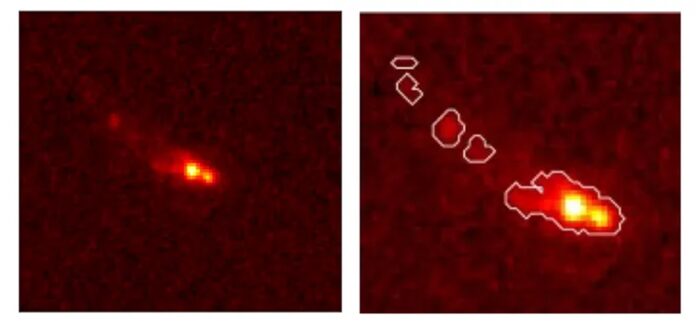The James Webb Space Telescope (JWST), which can peer into the early Universe, is helping astronomers make intriguing discoveries about its early history. Astronomers witnessing galaxies that are remarkably big and mature for their age are questioning notions about how galaxies develop and evolve.
One of the oldest galaxies ever discovered, Gz9p3, was recently the subject of an international research team’s study, which provided intriguing insights into its structure and past.
The name “Gz9p3” comes from the research team, the Glass collaboration, and the galaxy’s redshift value of z=9.3, which indicates its distance from us. With the James Webb Space Telescope, the team could observe it around 13 billion years ago, 510 million years after the Big Bang, as opposed to the single point of light previously visible through the Hubble Space Telescope.
Given its young age, Gz9p3 is surprisingly far more massive and mature than expected—it already contains several billion stars. Since it’s the largest verified object of this era, stars may have been created more quickly and efficiently than previously believed.
It is ten times more massive than any other galaxy found early in the Universe. These findings imply that stars had to form far more quickly and effectively than previously believed for the galaxy to reach this size.
In addition, its complex shape defines it as one of the earliest galaxy mergers ever witnessed. The galaxy’s JWST imaging shows a morphology that suggests two galaxies interacting, suggesting that a merger process is still underway. Surprisingly, there are two separate parts to the merger.
A large volume of matter is discharged during such huge mergers. This debris shows that we are looking at one of the furthest merging events in recorded history.
The scientists dug some deeper to examine the star population within the merging galaxies. They used the JWST to study the galaxy’s spectrum, which is the process of dividing its light into various wavelengths in the same way a prism divides white light into rainbows.
When studies of distant objects use solely image data, the results usually show that the stars are mostly young. This is because the light of younger, brighter stars dominates the imaging data. For example, a population ignited by the galaxy merger that is young and bright—less than a few million years old—tends to outgrow an older population that is more than 100 million.
However, they may obtain extremely detailed measurements that allow them to differentiate between these two populations using spectroscopy.
It was surprising to find a mature older population of stars because it was not thought stars could have formed and aged to a suitable degree by this early cosmic epoch. Thanks to precise spectroscopy, scientists were able to identify minor characteristics of the old stars, which confirmed their existence beyond first thought.
The presence of this older population is supported by elements found in the spectrum, such as silicon, carbon, and iron, which imply that they have enhanced the galaxy’s chemical composition.
Not only are the galaxies’ sizes astounding, but so is the rate at which they reached such a chemically developed state.
These studies prove a continuous galaxy merger-driven star and metal buildup shortly after the Big Bang. They show that contrary to what was previously believed, enormous galaxies with billions of stars existed earlier.
Whereas single galaxies gradually produce stars from their finite gas reserves, interactions and mergers among galaxies can significantly quicken this process by bringing in new gas sources. In particular, mergers offer a quick path for growth and bulk accumulation.
Even today, the biggest galaxies in the Universe have a history of merging, such as our own Milky Way, which has expanded through multiple mergers with smaller galaxies.
The results for Gz9p3 suggest that early Universe galaxies could merge to gain mass rapidly and that star formation could proceed at higher than expected rates.
Astrophysicists are adjusting their theories of the early Universe in response to these findings and additional JWST data.
These new results are well-timed as we approach the two-year mark for scientific observations made using the JWST.
Journal Reference:
- Boyett, K., Trenti, M., Leethochawalit, N. et al. A massive interacting galaxy 510 million years after the Big Bang. Nat Astron (2024). DOI: 10.1038/s41550-024-02218-7
